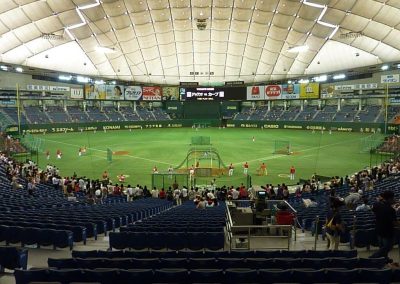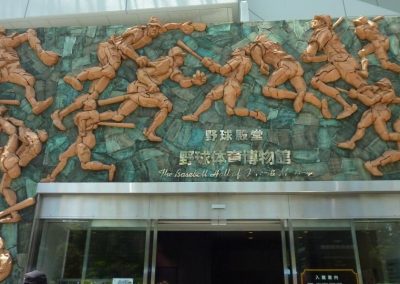Tokyo Dome - Yomiuri Giants
- Sean MacDonald

- Aug 1, 2013
- 6 min read
Updated: Jul 26
Photos by Sean MacDonald, Stadium Journey
Stadium Info FANFARE Score: 2.71
Tokyo Dome Koraku 1-3-61 Bunkyo-ku, Tokyo 112-0004, Japan
Year Opened: 1988 Capacity: 55,000
The Big Fried Egg
Built in 1988 to replace the outdoor Korakuen stadium, the Tokyo Dome was the first covered baseball venue in Japan. Nicknamed the Big Egg for its egg-like appearance from the air, it has become an icon in the city. It hosts the nation’s most popular pro team, the Yomiuri Giants, as well as dozens of college and industrial league games throughout the year. It also acts as a football stadium, race track, exhibition hall, and Japan’s largest concert venue. Much like the Metrodome in Minneapolis, the roof is a flexible membrane that is supported by slightly pressurizing the inside of the stadium.
From outside, the dome is bright and shiny, but the cover belies a rather drab interior that makes it one of the least enjoyable places to watch a game.
Food & Beverage 3
The offerings inside the park are fairly typical, with hot dogs seeming to be the most common choice. I saw one stand with 32 different types of bento boxes, so you certainly have your options on that front. The recommended local dish inside is the Big Egg ice cream sandwich, which consists of vanilla ice cream surrounded by a light crust shaped like the dome itself. It is sold by vendors walking around the stadium and is worth the 260 yen simply for the unique design rather than the taste.
The best food in my mind though comes from the restaurants that are built into the outer walls of the stadium. There are at least 5 decent eateries here, with my favorite being The Burgers Tokyo. It offers premium burger sets from 880 yen which provide a good pre-game meal and are much better than the pre-cooked patties available inside. The other restaurants are more traditional Japanese fare such as noodles or rice bowls, but I’ve never tried them because I enjoy the burgers so much.
As usual, you can bring food and drink into the ballpark and there are a number of shops near Korakuen station, as well as a McDonalds if you are desperate.
Atmosphere 2
The dome is fairly lifeless during a Giants game. It’s too big for the fans to really get together and make a lot of noise, even when it’s nearly sold out. The worst thing is the lack of decent air conditioning, which makes walking around the crowded concourse on a hot day a sweaty endeavor. Plastic fans are handed out at the entry and you better take one to keep cool during the game.
There are some mascots and a dance team, but they add little to the proceedings. I found the Sunday afternoon that I spent there to be a ho-hum affair and see no reason to return.
Neighborhood 4
The dome is part of a larger complex that includes the Tokyo Dome Hotel and Korakuen, an aging amusement park. The hotel has elevators that provide views that can be quite stunning as you race up 43 floors, but otherwise the whole place is fairly bland. It is all located in Bunkyo-ku, a rather non-descript area just north of the Imperial Palace. Suidobashi is the nearest big station, but it doesn’t have a lot of post-game entertainment choices.
If I were to suggest one bar, it would be Doma Doma, a cheap but tasty izakaya just a couple of minutes away from the JR Suidobashi station. It’s a chain with dozens of branches throughout Tokyo that offer a wide variety of Japanese food with pictures and English explanations in the menu. Quite affordable for the quality. Kanda is only a couple of stops away and this area definitely has more flavor and is typically Japanese, with some great bars and restaurants. I would advise that you get here and wander the streets, you are sure to find something of interest.
Fans 1
Disclosure: I hate the Giants and their fans, who are the worst of the lot here. They are front-runners, rooting for the most popular and richest team. But their cheering section is dull and has no interesting or catchy tunes. Worse, they chanted for a shutout when the other team was batting in the ninth inning, which I consider to be bad form. They also sit on the third base side when the first base seats are sold out, which is downright wrong. Suffice to say I was not impressed with them whatsoever.
Access 3
There are four lines that serve the area: Suidobashi has a JR station as well as the Toei Mita subway line while the Korakuen subway station has the Marunouchi and Namboku metro lines. I find the Mita line the best way to come and go as it is the least crowded, but most likely you’ll have to choose based on your starting point. One thing to be aware of is that the Dome is built on some restricted space and the pathways around it get very narrow in some places, particularly near the Korakuen station. After a game, be prepared to move very slowly as thousands of people are forced into a narrow passage.
You must enter the stadium at the correct gate. There are 6 gates at ground level (which is actually the second floor, so the gates number from 20-25), 4 gates for the next level (30-33), and 2 gates for the top level (40 and 41). Once inside the stadium, you can walk freely around before the game. However, during the game, you must show a ticket to enter the seating bowl on the lower level.
The concourse fills up as game time approaches, so if you want to tour, get there early (doors open 2 hours before the game). You can take the stairs to the top level and back, but again you may be asked for a ticket when you reach the lower bowl.
Return on Investment 2
Tickets here are not cheap, going as high as 5,900 yen for the S seats behind the plate, which are slightly more padded than the typical seat. My recommendation is the 2,300 yen C seat, which can be anywhere in the upper deck. These seem to have a bit more room and provide a nice view of the stadium as well as a less crowded concourse.
There are also Excite Seats that are on the field down the lines but these were not available at the box office on game day.
The outfield seats have no backs but are generally reserved for the cheering sections. There are also standing room tickets for just 1,000 yen but you need to arrive early and save your space with a newspaper or something similar, at least for a popular game. At the game I saw, I was able to find a standing space near home plate in the 6th inning and held that for the rest of the match.
As is common in Japan, there is protective netting down the entire baseline, which ruins the view for me and is another reason to sit upstairs.
The field itself is turf with dirt around the bases. The scoreboard is fairly standard and there are no interesting between-inning promotions. Essentially the Tokyo Dome is function over form but still costs a bit too much for what you get.
Extras 4
The Japanese Baseball Hall of Fame is located here and is the highlight of the entire experience. A bargain at only 500 yen (with a 100 yen discount if you show that day’s game ticket), the HOF boasts an impressive display of awards and memorabilia. The two WBC trophies greet you as you reach the bottom of the stairs, and from there you wander around checking out some excellent displays and a surprising amount of material from the major leagues. There are English explanations for each of the enshrined players, but not for the artifacts such as Jackie Robinson’s bat, so it helps to be accompanied by someone who can understand basic Japanese if you want to get the most out of the visit. An absolute must-see.
Within the Dome, the Giants have their own museum on the Fan’s Fun Plaza, a concourse beneath the main concourse. The museum is nothing more than a wall display that contains a few items celebrating the Giants’ successes. It isn’t very compelling unless you happen to be a fan, although it was interesting in that the game I saw had the winning ball from the previous day’s game, which was a rookie pitcher’s first complete game.
The Fan’s Fun Plaza also boasts the Star Memorial Plate area, which are plaques along the wall commemorating the past stars of the Giants as well as famous musicians and bands that have played there.
Final Thoughts
The Tokyo Dome is really not a pleasant place on a hot and humid afternoon, when it should be called the Big Fried Egg. It is still worth visiting if only for the Hall of Fame, but if you do go in the summer, I’d suggest an evening game.













Comments